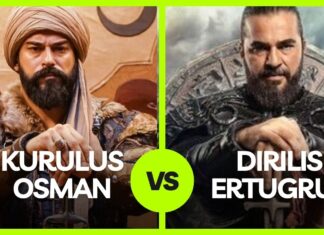Çandarlı Halil Pasha’s full name was Çandarlı Halil Pasha the Younger, as there had been another Grand Vizier with the same name, who served during the reign of Sultan Murad I. This earlier vizier, known as Çandarlı Halil Pasha the Elder, served as the Grand Vizier of the Ottoman Empire from 1364 until his death in 1381. His son, Çandarlı Ibrahim Pasha, also held the position of Grand Vizier during Sultan Murad I’s reign. After Sultan Murad I’s death, Sultan Bayezid I took over the throne, followed by Sultan Murad II.
The Byzantine Threat and Ottoman Response
Sultan Bayezid I’s grandson, Orhan, fled and took refuge in Constantinople, where the Byzantine emperor imprisoned him. In exchange for Orhan’s imprisonment, the Byzantine Empire would demand a hefty annual tribute from the Ottoman Empire. If the Ottomans failed to pay, the Byzantine emperor threatened to incite a rebellion in the Ottoman Empire using Prince Orhan. At that time, the Ottoman Empire had not expanded significantly, and the other Ottoman sultans, fearing rebellion, would pay tribute regularly to avoid conflict.

The Early Region of Sultan Mehmed the Conqueror
Sultan Mehmed the Conqueror was born in 1430. When he was only 12 years old, his father, Sultan Murad II, abdicated the throne in favor of his young son. Sultan Murad II’s decision to abdicate was heavily influenced by the death of his elder son, Şehzade Alaeddin, who was the crown prince and died in battle. Devastated by this loss, Sultan Murad II withdrew from political life and appointed his powerful vizier, Çandarlı Halil Pasha, as the guardian and mentor of Sultan Mehmed the Conqueror.
Tension Between Sultan Mehmed and Çandarlı Halil Pasha
From 1442 to 1444, Sultan Mehmed the Conqueror ruled with Çandarlı Halil Pasha as his Grand Vizier. However, Çandarlı Halil Pasha, viewing Sultan Mehmed as a child, often disregarded his orders and imposed his own decisions on the empire. This caused tensions between Sultan Mehmed the Conqueror and Çandarlı Halil Pasha. During this period, a war broke out between the Ottomans and Hungary. Sultan Mehmed the Conqueror requested his father, Sultan Murad II, to return and lead the army. Initially, Sultan Murad II refused, but Sultan Mehmed insisted, stating that if his father still considered himself the Sultan, he should return and lead the army, or if he recognized Mehmed as the Sultan, he must obey his order and return to lead the army. Sultan Murad II eventually returned, led the army, and won the battle against Hungary.

Sultan Murad II Return and the ongoing Struggle
After this victory, Sultan Murad II wanted to retake the throne. However, upon seeing the ongoing power struggle between his son and Çandarlı Halil Pasha, and recognizing the harm their rivalry was causing the empire, Sultan Murad II decided to reinstate Sultan Mehmed the Conqueror as the ruler. Sultan Mehmed the Conqueror, who became a formidable ruler during his 30-year reign, changed seven Grand Viziers, including appointing Ishak Pasha twice to the position of Grand Vizier. His strategic decisiveness helped expand the empire beyond Turkey into Europe, including the conquest of Constantinople, significantly increasing the empire’s territory.
Çandarlı Halil Pasha opposed the conquest of constantinople.
From 1444 until Sultan Murad II’s death in 1451, he held the throne, and upon his death, Sultan Mehmed the Conqueror, then only 21 years old, ascended the throne again. At this time, Çandarlı Halil Pasha remained as the Grand Vizier. Upon ascending the throne, Sultan Mehmed the Conqueror ordered his Grand Vizier to prepare the army for war against Constantinople and recruit young men from across the empire into the army. However, once again, Çandarlı Halil Pasha became an obstacle and strongly opposed the Sultan’s plan to attack Constantinople.

The Final Confrontation and Execution of Çandarlı Halil Pasha
Sultan Mehmed the Conqueror made significant changes, including removing Çandarlı Halil Pasha from his position as the head of the Janissary Corps and appointing another vizier to this role. Çandarlı Halil Pasha was furious with this decision and orchestrated a rebellion within the empire using the Janissary Corps, leading to the deaths of several Muslims. Çandarlı Halil Pasha repeatedly tried to dissuade Sultan Mehmed the Conqueror from attacking Constantinople and raised numerous obstacles against him. However, Sultan Mehmed the Conqueror was determined to conquer Constantinople, despite his Grand Vizier’s opposition.
By this time, Çandarlı Halil Pasha had become a complete enemy of the Ottoman Empire and Sultan Mehmed the Conqueror. He posed a great threat, as many key officials in the empire were loyal to him and could potentially incite a rebellion. Moreover, Sultan Mehmed the Conqueror also faced the looming threat of Prince Orhan, who was still imprisoned by the Byzantine emperor. It is said that Çandarlı Halil Pasha threatened the Sultan that if he did not abandon his plans to attack Constantinople, he would bring Prince Orhan back and have him installed as Sultan. Additionally, Çandarlı Halil Pasha wanted Sultan Mehmed the Conqueror to attack Hungary instead, so the empire and the Janissary Corps could seize substantial wealth.

conclusion
Seeing that his Grand Vizier had become a source of turmoil and posed a significant threat to the empire, Sultan Mehmed the Conqueror summoned him to court one day and, in front of all the other viziers, ordered his execution. Thus, in 1a451, this powerful vizier met a tragic end.












